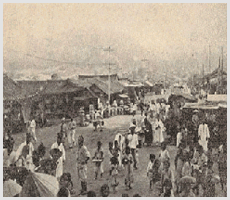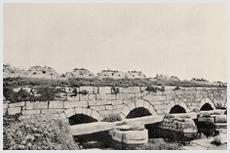|
|
 Gwangtonggyo (Bridge) Gwangtonggyo (Bridge) |
|
 |
Gwangtonggyo is a bridge built at the heart of Seoul to link the south with the north of the capital. Joseon kings used the bridge when they left the palace to make formal visits to a royal tomb of their ancestors. Also, Chinese envoys used Gwangtonggyo that led them to the palace through Sungnyemun, the south gate of the fortress wall protecting the capital. Gwangtonggyo was the largest (12 meters long and 15 meters wide) and the most magnificent of all the bridges built within the walled capital of Joseon.
When Gwangtonggyo was first built within the capital of the newly established dynasty, Joseon, it was nothing but a small earthen structure that was destined to be swept away along with many lives |
|
by an August torrent in 1410 (the 10th year of the King Taejong’s reign). It was rebuilt from stones taken from the royal tomb of Jeongneung, where Queen Sindeok, King Taejo’s second consort, was buried.
The decision of using the ceremonial and monumental stones from the queen’s tomb was made by Yi Bang-won, King Taejo’s fifth son who later took the throne to become the Joseon’s third monarch King Taejong, who had a deep-rooted hatred of her. History says that the conflicts between the two royals started in 1392 when the queen inspired King Taejo and his closest aides including Jeong Do-jeon to block the political influence of Bang-won, the youngest son from the first queen who had since died, and gave the title of crown prince to her
own son, Bang-seok. The queen’s efforts to take her son to the throne, however, went for naught when she met an abrupt death in 1396. Two years later, the crown prince and his supporters including Jeong were brutally murdered by his ambitious stepbrother, Bang-won, in an incident that is now remembered as the First Princes’ Rebellion. Meanwhile, King Taejo had the tomb of his beloved queen built on a hill in Chwihyeonbang (today’s Jeong-dong), a central district within the capital, so that he could visit it whenever he wanted, and gave the tomb the title of Jeongneung. He then ordered to his ministers including the Jeju governor Yeo Ui-son to mobilize the best stonemasons in his kingdom and decorate the tomb with fine monumental stones. The king visited the grave
quite often to express his love for her. The death of the dynasty founder in 1408 and the following rule of Joseon by Yi Bang-won as King Taejong instigated a row among ministers over the location of the tomb. Ministers argue that the tomb should be moved out of the capital because no tombs, including royal ones, had ever been located within the capital. It was in the following year that the tomb was moved to the current location in Jeongneung-dong of Seongbuk-gu in Seoul.
|
| The queen’s grave had to face another gruesome misfortune during the rainy season in the following year when a flood swept away the earthen structure of Gwangtonggyo because King Taejong wanted to build a new bridge with the monumental stones honoring her tomb. The king thought that by using the monumental stones as steps for the crowds of citizens, it would be a great way of exacting revenge for the way she had treated him. His intention though was effectively betrayed because the newly built stone bridge turned out to be admired as the finest bridge in the capital for over 500 years till the end of the dynasty, and loved for all that time by his royal |
|
 |
|
| descendants and foreign envoys visiting their palaces. The remaining stones of the bridge include elaborately carved stone guardians and monuments lavishly decorated with find cloud and vine designs exhibiting the King Taejo’s love for his second wife. |
 |
| It was during the Japanese colonial rule of Joseon in the early 20th century that Gwangtonggyo began to receive shameful treatment. The first serious damage was inflicted on the bridge in early 1900’s when a tramline was built along the eastern side of the bridge. In 1918, the bridge was extended and reinforced with ferroconcrete structures with the original stone railings moved to the extended sides. The 1923 construction project of installing drain pipes along the Cheonggyecheon waterway also left a permanent scar on the bridge when the pipes were installed through the stone guardians supporting the bridge at both southern and northern ends. Another huge public work aimed to cover Cheonggyecheon in the 1950s took away the
bridge’s western railings in 1954 and the eastern railings in 1958. |
|
|
| |
|
|
|
|
|
|






